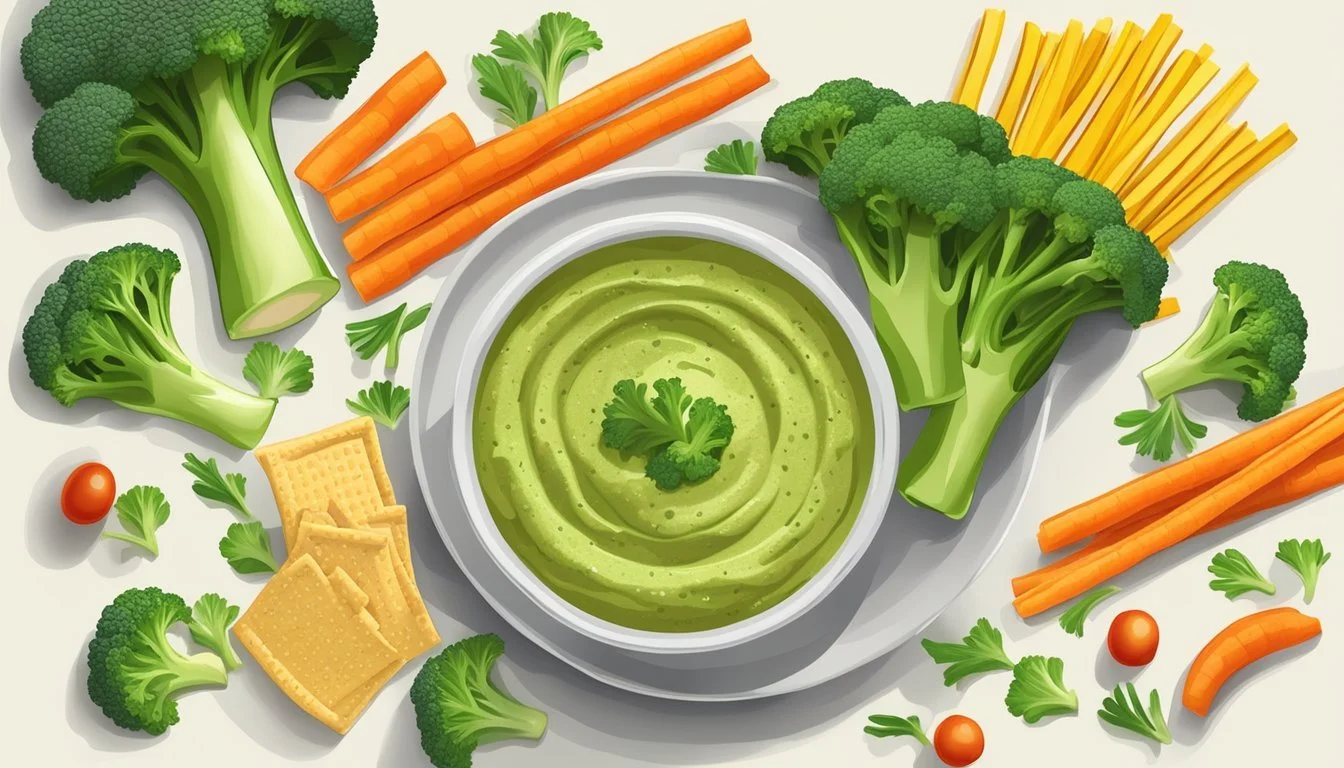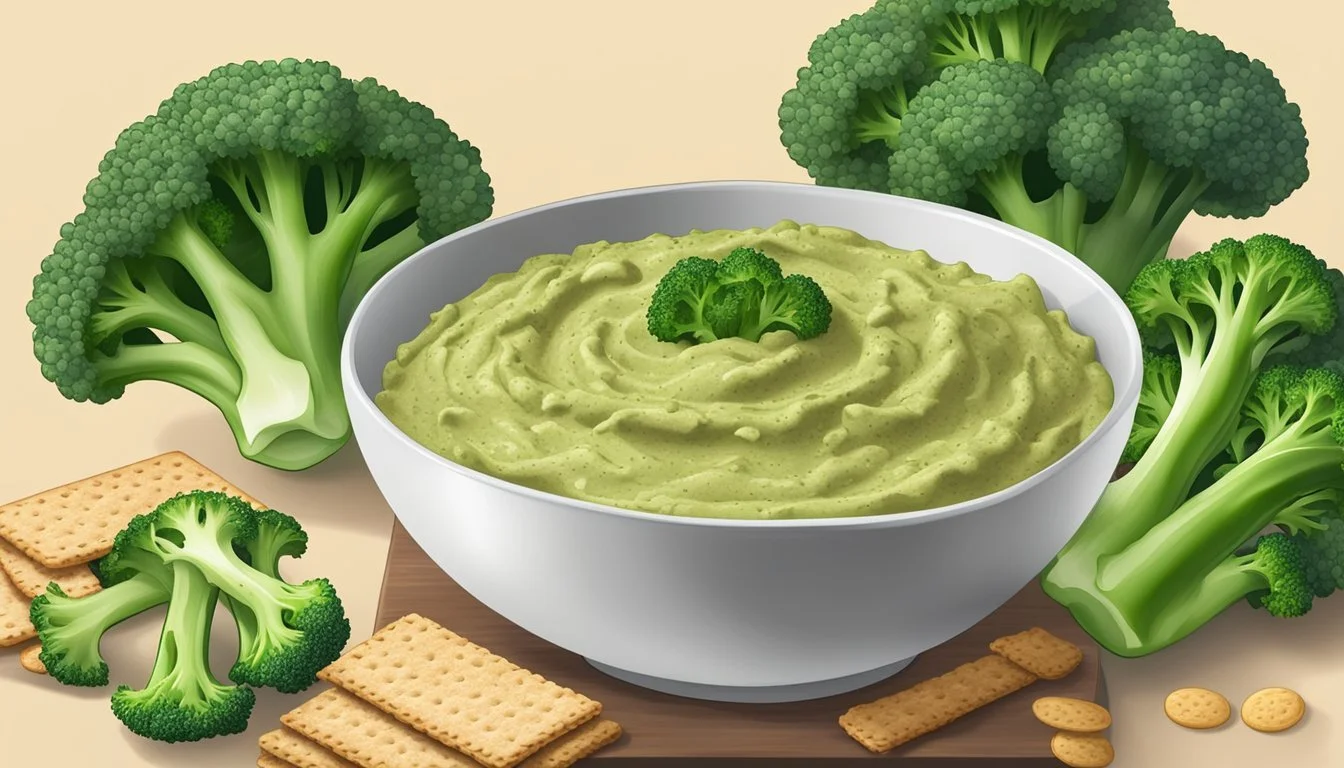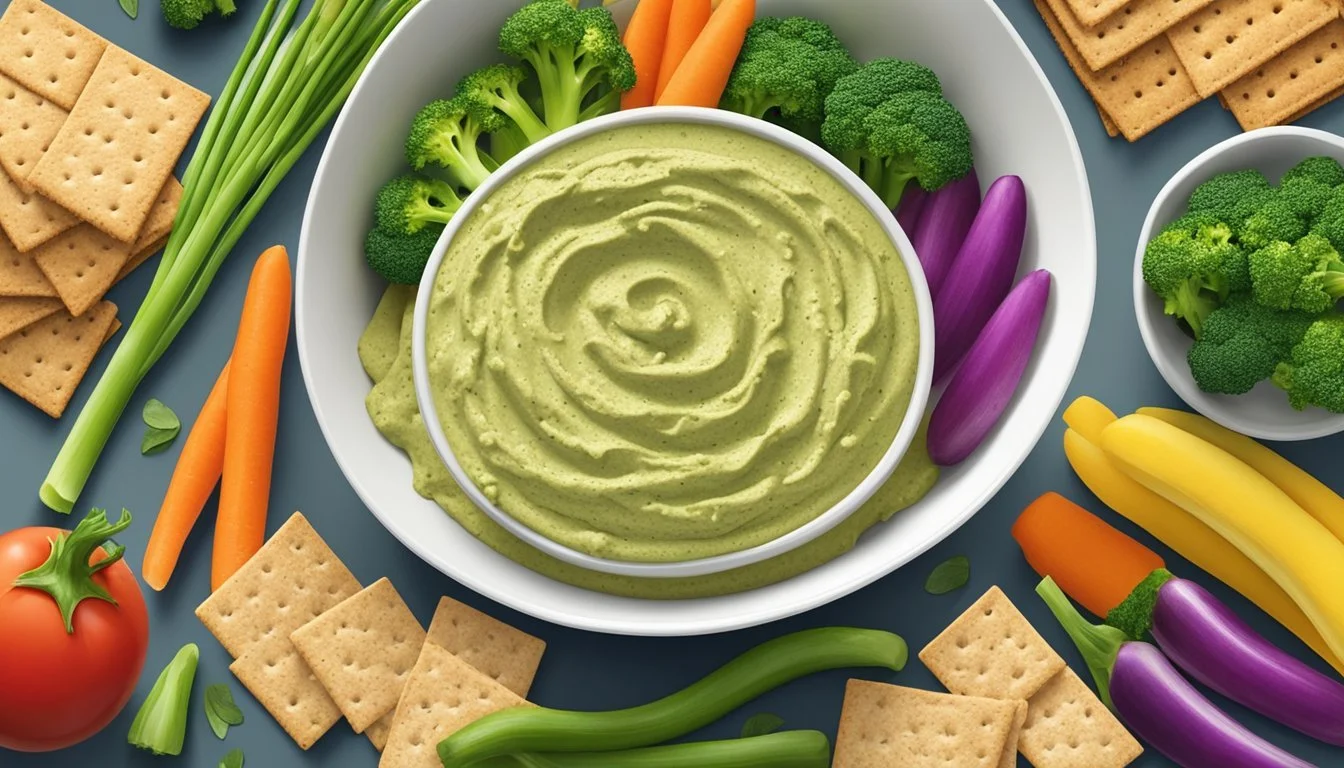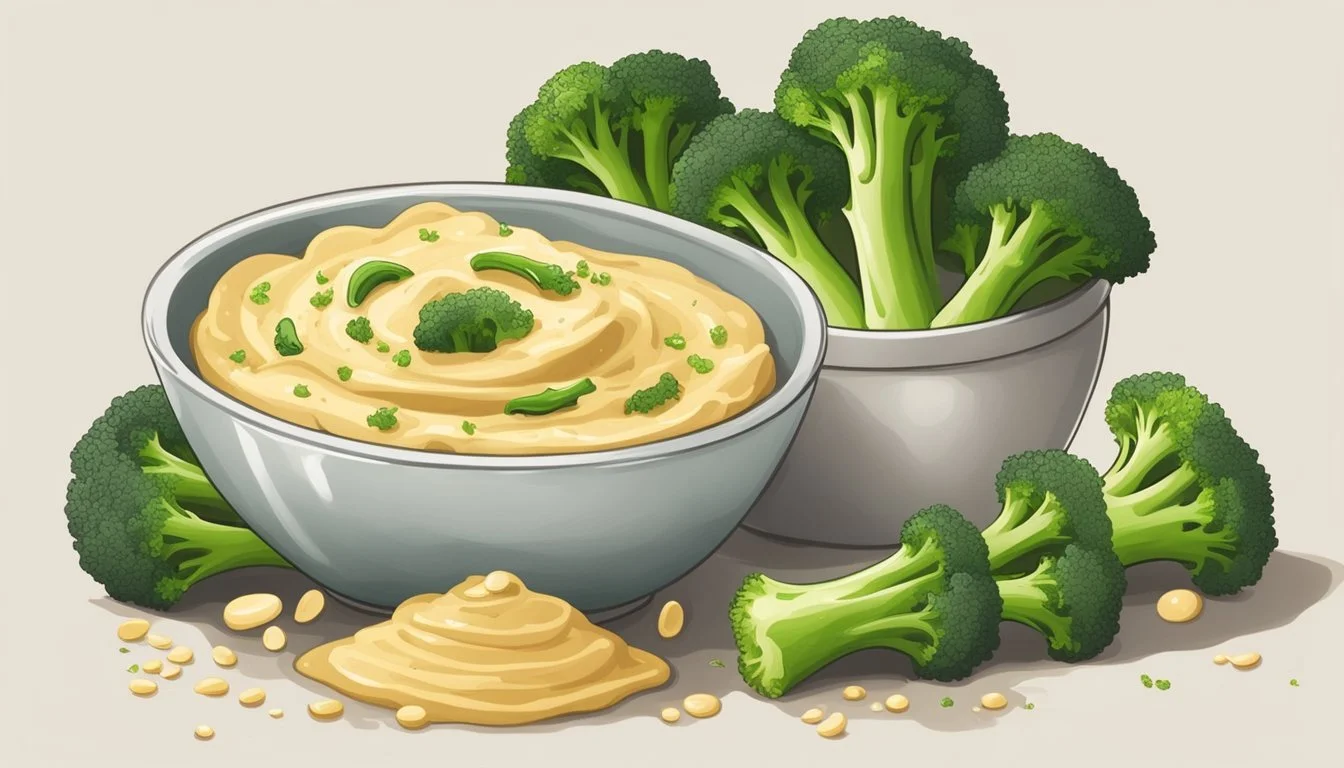Broccoli Stem Hummus
A Nutritious Twist on Traditional Dips
Broccoli stem hummus is an innovative twist on the traditional Middle Eastern dip, usually made with chickpeas, tahini, olive oil, lemon juice, and garlic. By incorporating the often-discarded stems of broccoli, this version not only reduces food waste but also enhances the nutritional profile of the hummus. Rich in fiber, vitamins, and minerals, broccoli stems lend a unique flavor and a creamy texture to the dip. This plant-based alternative is suitable for those following a vegan diet, offering an excellent source of protein and nutrition while still delivering on taste.
Crafting hummus from broccoli stems is a creative way to enjoy a staple that has become a favorite in healthy eating circles. The preparation process typically involves peeling the tough outer skin of the stems to reveal the tender core, which is then boiled or steamed until soft. Blending the cooked stems with traditional hummus ingredients results in a vibrant green spread that pairs well with a variety of dishes. From veggie platters to wraps, this broccoli stem hummus adds a fiber-rich, creamy element to any meal.
Nutritional Profile of Broccoli Stem Hummus
Broccoli Stem Hummus combines the health benefits of broccoli stems with the rich nutrients found in traditional hummus ingredients. This creates a dip that's both delicious and supportive of overall health.
Fiber Content and Digestive Benefits
Broccoli stems are an excellent source of fiber, which contributes to digestive health. The inclusion of broccoli stems in hummus increases the dietary fiber content, aiding in digestion and potentially helping to reduce the risk of chronic diseases.
Vitamins and Minerals in Broccoli Stems
Broccoli stems pack a nutritious punch, rich in vitamins A and C, folate, and potassium. Vitamin C acts as an antioxidant, supporting the immune system, while potassium is pivotal for maintaining healthy blood pressure levels.
Vitamin A: Essential for vision and immune functions.
Vitamin C: An antioxidant aiding in cellular repair and immunity.
Folate: Important for cell division and the synthesis of DNA.
Potassium: Benefits heart health and fluid balance.
Protein and Healthy Fats
Protein in this hummus comes from chickpeas and tahini (sesame seed paste), providing the building blocks for muscles and tissues. Healthy fats are derived from tahini and olive oil, which are known for their anti-inflammatory properties and are important for heart health.
Protein: Builds and repairs tissues.
Healthy Fats: Support brain health and reduce inflammation.
Culinary Applications
Broccoli stem hummus marries the creamy texture of traditional hummus with the added fiber and nutrients of broccoli stems. It's made simply in a food processor and its versatility extends from a classic dip to an innovative addition in various meals.
Hummus as a Versatile Dip
Broccoli stem hummus shines as a versatile dip suitable for various occasions. Packed with a creamy texture, it serves as both an appetizer and a snack, meeting the needs of health-conscious individuals without compromising on flavor. This dip pairs impeccably with:
Veggies: Carrots, cucumber, celery, and bell peppers.
Crackers and Chips: Pita chips, whole grain crackers, or tortilla chips.
The dip's versatility is underlined by its ability to meld with a wide array of flavors, making it perfect for gatherings where taste preferences vary.
Innovative Uses in Meals
The innovative cook will find broccoli stem hummus to be a remarkable addition to meals:
Sandwich Spread: A layer of broccoli hummus adds a nutritious twist to sandwiches.
Buddha Bowls: A dollop on top adds both a creamy texture and an extra punch of flavor.
By incorporating just 7 wholesome ingredients including broccoli stems, garlic, tahini, lemon juice, herbs, olive oil, and salt, one can transform this humble dip into a cornerstone of numerous creative recipes.
Preparing Broccoli Stem Hummus
Creating a homemade broccoli stem hummus involves combining fiber-rich stems with a medley of flavorful ingredients to produce a creamy and delicious dip. This section walks through the essential components, blending process, and how to enhance the hummus's flavor.
Essential Ingredients
Broccoli Stems: Fresh stems should be boiled until tender before use.
Tahini: A paste made from sesame seeds, crucial for authentic hummus.
Lemon Juice: Adds a fresh, citrusy zing.
Garlic: Crushed or minced for a pungent flavor.
Olive Oil: A high-quality oil ensures richness and smoothness.
Chickpeas: The traditional base of hummus, providing creaminess and protein.
Spices: Salt is essential, but spices like cumin and turmeric can be added for depth.
Herbs: Fresh dill or other herbs infuse freshness into the dip.
The Blending Process
Boil the prepared broccoli stems in salted water until tender, approximately 5 minutes.
Immerse the boiled stems in an ice bath, drain and add to a high-speed blender.
Incorporate garlic, tahini, lemon juice, olive oil, chickpeas (if using), and a pinch of salt.
Blend on high until the mixture reaches a creamy consistency, pausing to scrape down the sides as needed.
Flavor Enhancements
To elevate the taste of the homemade hummus:
Drizzle additional olive oil on top for richness.
Use a dash of cumin, tumeric, or ginger for warmth and complexity.
Fresh lemon juice can be adjusted to preference for tanginess.
Incorporate finely chopped fresh dill or other herbs for a Mediterranean twist.
Sprinkle lightly with sesame seeds before serving for added texture and flavor.
Serving Suggestions
Broccoli stem hummus is a versatile dip with a creamy texture that lends itself to a variety of serving options. Whether it is presented as an appetizer or enjoyed as a wholesome snack, this fiber-rich hummus can elevate simple ingredients to delightful flavor combinations.
Healthy Snack Pairings
The thick, creamy consistency of broccoli stem hummus makes it an ideal partner for fresh, crunchy vegetables. A platter of vibrant, sliced veggies not only adds a nutritional punch but also a playful array of colors to the table. Consider these pairings:
Carrots: Either baby carrots or carrot sticks offer a sweet, crunchy contrast.
Celery Sticks: Their mild flavor complements the hummus without overpowering it.
Cucumber Slices: Fresh and hydrating, cucumber plays well with the creaminess of the hummus.
Radish Slices: A hint of peppery bite from radish slices adds an exciting layer of flavor.
Snap Peas: Their crispy texture and sweet taste blend seamlessly with the hummus.
Bell Pepper Strips: Choose a mix of colors for a visually appealing and tasty snack.
Broccoli Florets: Double up on broccoli for a harmonious pairing.
Bread and Cracker Companions
Bread and crackers provide a satisfying crunch and structure for scooping up generous amounts of broccoli stem hummus. Their subtle flavors allow the hummus to shine as the star of the show:
Pita Bread: Soft and slightly chewy, it's the traditional go-to for all kinds of hummus.
Flatbread: Offers a heartier base and can be warmed for added comfort.
Crackers: Opt for whole grain or seeded varieties for extra texture and nutrition.
Chips: Baked pita chips or tortilla chips can add a satisfying crunch.
Creative Garnishes
The presentation of the dip can be as important as its taste. Adding garnishes not only elevates the aesthetic appeal but can also enhance the flavor profile of the hummus:
Cilantro: A sprinkle of fresh cilantro leaves adds a burst of herbal freshness.
Roasted Red Pepper: Finely diced roasted red pepper provides a sweet and smoky accent.
Garnish: Consider a drizzle of olive oil and a sprinkle of paprika or toasted sesame seeds for a touch of elegance and a hint of additional flavor.
By following these serving suggestions, one can turn broccoli stem hummus into the centerpiece of a table spread. Its ability to complement a diverse set of accompaniments makes it a standout choice for nutrition-conscious individuals seeking flavor without compromise.
Health and Dietary Considerations
When considering Broccoli Stem Hummus for dietary intake, one should factor in its calorie content for weight management, consider any potential allergens, and recognize the benefits derived from its plant-based ingredients.
Weight Management and Calories
Broccoli Stem Hummus is a low-fat option that contributes nutritious, plant-based protein to one's diet. It can be particularly beneficial for those looking to manage their weight, as the fiber-rich broccoli and protein from chickpeas or alternate legumes, like lentils or white beans, help promote satiety.
Calories: Moderately low (specifics vary based on recipe modification)
Fat: Low-fat content
Allergen Information
For individuals with dietary restrictions, it's important to note that Broccoli Stem Hummus can be made gluten-free and dairy-free, thus suitable for vegan diets. However, caution is advised for those with allergies to sesame, as tahini—a common ingredient—is derived from sesame seeds.
Gluten-Free: Can be gluten-free if using ingredients without gluten contamination.
Dairy-Free: Naturally dairy-free
Sesame Allergy: Check for tahini content; substitute if necessary
Benefits of Plant-Based Ingredients
The ingredients in Broccoli Stem Hummus offer several nutritional benefits. Broccoli is a source of fibers that aid in digestion and also contains anti-inflammatory properties. Vitamins such as vitamin A and vitamin C, and minerals like magnesium and potassium, contribute to overall well-being.
Nutrition: High in vitamins and dietary fiber
Digestion: Fiber aids in healthy digestion
Anti-inflammatory: Ingredients contain compounds with potential anti-inflammatory effects
Plant-Based Protein: Chickpeas, lentils, or white beans provide a good source of vegan protein
Comparison With Other Dips
When exploring the diverse world of dips, Broccoli Stem Hummus stands out for its unique combination of nutrients and its versatile flavor profile. This section examines how it stacks up nutritionally against other popular dips and explores the variety in its taste and texture.
Nutritional Comparison
A comparison of Broccoli Stem Hummus with other dips such as salsa, mayo, guacamole, and various hummus variants reveals compelling differences:
Fiber Content: Broccoli Stem Hummus is rich in fiber, contributing positively to digestive health. Compared to mayo, which lacks fiber, broccoli hummus provides a nutritious edge.
Vitamins and Minerals: The high concentration of vitamins and minerals in the broccoli stems means that this hummus variant is more nutrient-dense than many other spreads, including white bean dip and roasted beet hummus.
Calories and Fat: With broccoli as a primary ingredient, the dip tends to be lower in calories and fats, unlike guacamole, which, while healthy, is higher in fats due to the avocados.
Salsa vs. Broccoli Stem Hummus
Salsa: Usually lower in calories but not as nutrient-dense.
Broccoli Stem Hummus: Higher in fiber and essential nutrients.
Mayo vs. Broccoli Stem Hummus
Mayo: High in fats, low in beneficial nutrients.
Broccoli Stem Hummus: More balanced with valuable dietary fiber and micronutrients.
Guacamole vs. Broccoli Stem Hummus
Guacamole: Rich in healthy fats, vitamins, and minerals but higher in calories.
Broccoli Stem Hummus: A fiber-rich alternative with a similar nutrient profile while being lower in calories.
Flavor and Texture Variants
Mild Flavor: Broccoli Stem Hummus has a milder flavor than roasted jalapeño hummus or dips with a significant zing to them, making it a versatile base for incorporating different taste preferences.
Creaminess: Its texture is creamy and comparable to traditional hummus, potentially more so than dips like salsa, which is typically chunkier.
Garlic and Spices: Adding garlic enhances its depth of flavor, while it remains more balanced and neutral compared to bold-flavored dips such as roasted beet hummus or roasted jalapeño hummus.
Appeal: For those desiring a delicious, health-conscious dip, Broccoli Stem Hummus provides not only a unique taste but also the benefits of fiber, vitamins, and minerals.
Recipe Variations
Broccoli stem hummus is a versatile dish that can be customized with various ingredients to suit different tastes. This section explores some traditional and global twists that can be applied to the basic recipe.
Traditional and Global Twists
Mediterranean Flair: Incorporating roasted tomatoes into the broccoli stem hummus adds a sun-kissed Mediterranean touch. The rich, concentrated flavor of the tomatoes complements the creamy texture of the hummus. Simply blend in roasted cherry tomatoes after processing the other ingredients to maintain a bit of chunky texture.
Middle Eastern Zest: To give the hummus a Middle Eastern spin, enhance it with cumin and black pepper. The warmth of cumin pairs well with the nutty broccoli stems, while black pepper adds a subtle heat.
Ingredients:
1 tsp ground cumin
¼ tsp ground black pepper
Golden Goddess Variation: For a turmeric-infused 'Golden Goddess' version, blend in ground turmeric with the basic hummus ingredients. The turmeric not only adds a vibrant golden hue but also an earthy flavor and potential anti-inflammatory benefits.
Ingredients:
1 tsp ground turmeric
Mexican-inspired: Black beans and red onion contribute a hearty Mexican-inspired twist to this dip. Swapping in lime juice for lemon juice further accentuates the Mexican profile. With black beans providing additional protein and fiber, this variation is as nourishing as it is flavorful.
**Ingredients:**
- ½ cup cooked black beans
- 2 tbsp finely chopped red onion
- Substitute lemon juice with lime juice
These variations offer a glimpse into the possibilities of transforming traditional broccoli stem hummus into a globally inspired dip.Preservation and Leftovers
Proper preservation of homemade broccoli stem hummus is crucial for maintaining its freshness and preventing food waste. Careful storage ensures that the leftovers remain enjoyable for subsequent snacking.
Storing Homemade Hummus
When storing homemade broccoli stem hummus, it's essential to keep it in an airtight container to prevent the growth of bacteria and to maintain its moisture content. The container should be placed in the refrigerator to keep the hummus chilled. It's best consumed within three to five days to enjoy its optimal flavor and texture.
Temperature: The refrigerator should maintain a steady temperature of 40°F (4°C) or below.
Placement: Store the hummus on a shelf rather than in the door to avoid temperature fluctuations.
To extend freshness:
Press a piece of plastic wrap directly on the surface of the hummus before sealing the container.
If any separation occurs, stir the hummus before serving to redistribute ingredients.
Note: Avoid freezing the hummus as this can alter its consistency and flavor profile.
Finally, always use a clean utensil to scoop the hummus. This will prevent cross-contamination and help maintain the quality of the leftovers.
Additional Information
In this section, readers will find answers to common inquiries about Broccoli Stem Hummus and learn about the rich history that surrounds the traditional hummus dish. This dip not only brings a twist to the classic recipe but also incorporates nutritional value from an often-discarded part of broccoli.
Frequently Asked Questions
Q: What is the nutritional value of Broccoli Stem Hummus?
A: Broccoli Stem Hummus is rich in fiber and contains a variety of nutrients including vitamin C, potassium, and iron due to the inclusion of broccoli stems.
Q: Can the stems of any type of broccoli be used for hummus?
A: Yes, the stems of both common and specialty broccoli varieties can be used to create this nutritious hummus.
History of Hummus
The Origins of Hummus:
Hummus is a traditional dish that traces its roots to the Middle East. The basic recipe for classic hummus includes chickpeas, tahini, lemon juice, and garlic.
Evolution Over Time:
Throughout the years, many variations have emerged, and creative adaptations like Broccoli Stem Hummus reflect the ever-evolving culinary landscape, making use of ingredients that align with a sustainable and health-conscious approach.
Conclusion
Broccoli stem hummus is a testament to the versatility and nutritional value of what might otherwise be discarded. This creamy dip is as flavorful as it is rich in fiber, making it an excellent choice for health-conscious individuals. Utilizing the broccoli stems, an often overlooked part of the vegetable, means less waste and more innovative cooking.
The dip boasts a smooth texture that results from the combination of tender broccoli stems, tahini, and olive oil. It's a flexible base that can be enhanced with various herbs, spices, and aromatics to suit any palate.
Nutrition also stands out in broccoli stem hummus. It's not just pleasing to the taste buds, but also kind to the body. The stems are packed with fiber, aiding in digestion and the promotion of a healthy gut. This hummus provides a welcomed alternative to traditional chickpea-based hummus, especially for those looking to include more greens in their diet.
Lastly, this hummus exemplifies how a mindful approach can lead to delicious, nutritive creations. It encourages reduced food waste while delivering a dish that is both nutrient-dense and delectable. Chefs and food enthusiasts can confidently incorporate broccoli stem hummus into their culinary repertoire, knowing they are making a choice that benefits both the palate and the planet.







